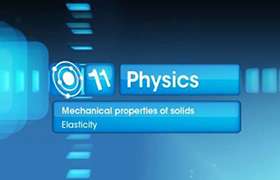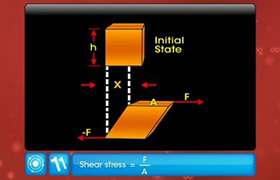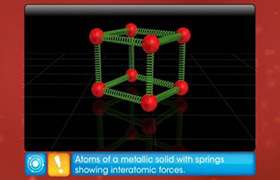CBSE Class 11-science Answered
Both stress and pressure are force per unit area.So, what's the difference b\w them?
Asked by keerthi b | 29 Nov, 2010, 12:00: AM
Like force and velocity, stress is a vector quantity. The stress vector can be resolved into a component perpendicular to the surface (the normal stress), and a component parallel to the surface (the tangential, or shear stress).
The stress field about any point in the body may be isotropic (also called hydrostatic) or anisotropic (non-hydrostatic). If we imagine a simple, infinitesimal cube, with its sides oriented orthogonally to the three cartesian coordinates, we can define a normal stress, S1, S2, S3 perpendicular to each pair of sides of the cube. These stresses are defined so that S1>S2>S3. Note that stress has units of Pascals = N/m², (where N = newton). The Pascal is the SI unit of pressure.
Pressure
When the stress field is hydrostatic, S1=S2=S3 = P, where P = pressure. Pressure is a scalar (non-directional) quantity; stress is directional. Only when the stress field is isotropic does a thermodynamic pressure exist.
Answered by | 30 Nov, 2010, 01:17: AM
Concept Videos
CBSE 11-science - Physics
Asked by desaipravinbhai63 | 28 Dec, 2023, 07:59: PM
CBSE 11-science - Physics
Asked by bhavanamajeti999 | 18 Dec, 2023, 03:33: PM
CBSE 11-science - Physics
Asked by harshitajain5757 | 05 Dec, 2023, 12:45: AM
CBSE 11-science - Physics
Asked by pavank3529 | 19 Jun, 2022, 04:39: PM
CBSE 11-science - Physics
Asked by ankitkg62880 | 04 Mar, 2022, 10:05: PM
CBSE 11-science - Physics
Asked by radhakrishna200329 | 15 Feb, 2022, 09:10: PM
CBSE 11-science - Physics
Asked by advssdrall | 10 Nov, 2021, 09:01: PM
CBSE 11-science - Physics
Asked by souravkheto234 | 17 Jun, 2021, 12:13: PM
CBSE 11-science - Physics
Asked by medhavi1615 | 21 May, 2021, 11:32: AM
CBSE 11-science - Physics
Asked by psvishnu888 | 20 Dec, 2020, 11:00: PM






